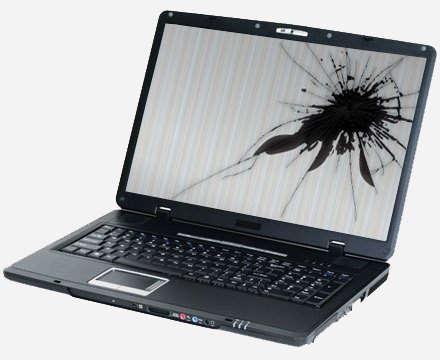The most fragile component of a laptop is the laptop screen. But it can also be one of the most expensive parts to replace. The good news is that you normally only need to replace the laptop screen if there is physical damage, if you see horizontal or vertical lines, or if the CCFL (back-light) is faulty. Below are problems and possible solutions to check to see if you need a new laptop screen.
Each of these issues are addressed in detail below:
DEAD PIXELS:
"Dead (Defective) Pixels" are dots on an LCD screen that remain unlit (fail to reproduce light levels correctly), or black, when it should be activated and displaying a colour. Each pixel on a laptop screen is made from three separate subpixels: red, green and blue. When combined, it forms the colours that users see on the screen. A dead pixel occurs when the transistor which regulates the amount of light that shows through all three subpixels malfunctions and results in a permanently black pixel. (Sorry for being so scientific there) Dead pixels are rare and largely go unnoticed by laptop users.
![]()
Solutions:
Dead pixels are usually caused by manufacturing defects, and they will often stay illuminated for the life of the laptop screen. In many cases it's possible to fix the pixel using either software tools or manual manipulation.
- A software solution will generally flash a series of images that vary in colour and intensity onto the screen in an effort to unstick the pixel.
- Manual manipulation involves gently pressing on the affected area with something like a pencil eraser. Doing this compresses the layers of the panel, forcing the oil within the panel to move. NOTE: This method is not guaranteed to work, and it may damage your laptop screen.
DIM SCREEN:
The ratio of the brightest white to the darkest black on a laptop screen or monitor. The larger the number, the darker the black is displayed.

The cold-cathode flourescent tube(backlight) is broken or the inverter is bad. Press the front panel on your LCD monitor to see if the OSD comes up. If it does, then it's a bad inverter and this is what's needed to be replaced. If the inverter is malfunctioning then it won't light up the lamps on your LCD, leaving the monitor with a dim display. With a laptop screen you generally won't be able to bring up an OSD, so you will need to visit a repair centre to have it looked at.
CRACKED SCREEN:
The laptop screen is one of the most fragile parts of the laptop - easily the most commonly broken. Don't worry if you've broken yours. You are not the first.

Solutions:
Cracked laptop screens in general can not be repaired and should be replaced. We replace all brands of laptop screens.
LINES:
A screen defect whereby a laptop screen exhibits vertical or horizontal lines, which are not due to a defect of the laptop itself.

Solutions:
Connect your laptop to an external monitor. If you don't see any lines on the external monitor than it's an indication that the laptop screen is faulty and should be replaced. We replace all brands of laptop screens.
BLACK SCREEN:
An Electronic Defect whereby the laptop screen does not render an image and is not caused by a defect in another component of the laptop.

Solutions:
The LCD screen does not have enough brightness or a black screen on a laptop display are usually due to a defective or dead backlight (CCFL) or voltage inverter that supplies high voltage to it.
FLICKERING SCREEN:
Flickering is an visible fading between cycles displayed on video displays, which is the monitor's refresh rate, the speed with which the screen is redrawn. If the refresh rate is too slow, the screen will appear to glimmer (the persistence of the screen phosphors). Low-persistence phosphors fade more quickly than high-persistence monitors, making the screen to flicker more.

Solutions:
- Check the cable: The cable from the motherboard to the inverter. This cable can get damaged due to twists when opening/closing the laptop.
- Check the inverter. It's a circuit board that controls electric flow to the screen.